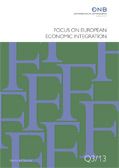Focus on European Economic Integration Q1/14
 OeNB
OeNB
- published:
- March 2014.
 OeNB
OeNB
Call for Entries: Olga Radzyner Award 2014 for Scientific Work on European Economic Integration (PDF, 1.2 MB) Focus on European Economic Integration Q1/14 en Mar 31, 2014, 12:00:00 AM
Call for Applications: Visiting Research Program (PDF, 330 kB) Focus on European Economic Integration Q1/14 en Mar 31, 2014, 12:00:00 AM
Do the Drivers of Loan Dollarization Differ between CESEE and Latin America? A Meta-Analysis
(PDF, 1.3 MB)
Hake, Lopez-Vicente, Molina.
Mariya Hake, Fernando Lopez-Vicente, Luis Molina – Focus on European Economic Integration Q1/14
In this paper we compare the determinants of loan dollarization in two emerging market
regions, namely Central, Eastern and Southeastern Europe (CESEE) and Latin America, through a meta-analysis of 32 studies that provide around 1,200 estimated coefficients for six drivers of foreign currency lending. As a common pattern, we find macroeconomic instability (as expressed by inflation volatility) and banks’ funding in foreign currency to play a significant role in explaining loan dollarization in both regions. In contrast, the interest rate differential appears to be a key determinant only in Latin America, while the positive impact of exchange rate volatility on dollarization implies a more prominent role for supply factors in the CESEE region. While the robustness of the results has been verified, our meta-analysis shows that estimates reported in the literature tend to be influenced by study characteristics such as the methodology applied and the data used.
en
foreign currency loans, CESEE, Latin America, metaregression, random effects maximum likelihood
C5, E52, F31, O57, P20
Mar 31, 2014, 12:00:00 AM
Can Trade Partners Help Better FORCEE the Future? Impact of Trade Linkages on Economic Growth Forecasts in Selected CESEE Countries
(PDF, 2.2 MB)
Slacík, Steiner, Wörz.
Slačík, Steiner, Wörz – Focus on European Economic Integration Q1/14
For Central, Eastern and Southeastern European (CESEE) countries, the euro area is the most
important export destination. Nevertheless, geographical export patterns differ among
individual CESEE countries, and economic growth within the euro area has diverged in the
run-up to and since the economic and financial crisis. We therefore examine the effects such
heterogeneous developments have had on trade – and thus economic growth – in CESEE.
Given the importance of such spillovers for macroeconomic projections, we evaluate the
OeNB’s macroeconomic forecasting model (FORCEE) for Bulgaria, Croatia, the Czech
Republic, Hungary, Poland and Romania. The FORCEE model captures trade spillovers via
aggregate demand from the euro area. We challenge this simplification by introducing a more
differentiated representation of the regional structure of trading partners. Our results show
that such a modification improves the forecasting performance of our structural macro model
in particular for the three Southeastern European countries in our sample. However, our tests
do not yet account for the additional uncertainty introduced into the model by broadening the
set of external assumptions, when we cover external demand from a wider range of partner
countries.
en
trade linkages, forecasting; Central, Eastern and Southeastern Europe
C14, C53, E37, F17
Mar 31, 2014, 12:00:00 AM
The Cyclical Character of Fiscal Policy in Transition Countries
(PDF, 877 kB)
Kabashi.
Kabashi – Focus on European Economic Integration Q1/14
This study investigates the cyclical character of fiscal policy in transition countries in Central,
Eastern and Southeastern Europe (CESEE) in the period from 1995 to 2011, using system
GMM as the preferred estimation method for the underlying sample and model specification.
The study finds discretionary policy in the CESEE EU Member States and in the Western
Balkan countries to have been procyclical, thus aggravating economic fluctuations, whereas
automatic stabilizers moved overall policy to an acyclical stance. In addition, the analysis
indicates considerable differences in the cyclical character of fiscal policy between transition
countries and the Western European EU Member States, where both overall fiscal policy and
discretionary policy were acyclical. Finally, the study also offers several recommendations for
policymakers, particularly in transition countries.
en
fiscal policy, transition countries, European Union, system GMM
H62, E32, C33
Mar 31, 2014, 12:00:00 AM
CESEE-Related Abstracts from Other OeNB Publications (PDF, 989 kB) Focus on European Economic Integration Q1/14 en Mar 31, 2014, 12:00:00 AM
Conference on European Economic Integration 2013 – Financial Cycles and the Real Economy: Lessons for CESEE (PDF, 1.2 MB) Focus on European Economic Integration Q1/14 en Mar 31, 2014, 12:00:00 AM
Olga Radzyner Award Winners 2013 (PDF, 1.5 MB) Focus on European Economic Integration Q1/14 en Mar 31, 2014, 12:00:00 AM
EBRD Transition Report 2013: Stuck in Transition? (PDF, 1.6 MB) Focus on European Economic Integration Q1/14 en Mar 31, 2014, 12:00:00 AM
Notes (PDF, 172 kB) en Mar 31, 2014, 12:00:00 AM
Referees for Focus on European Economic Integration 2011−2013 (PDF, 952 kB) en Mar 31, 2014, 12:00:00 AM